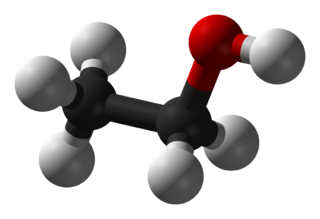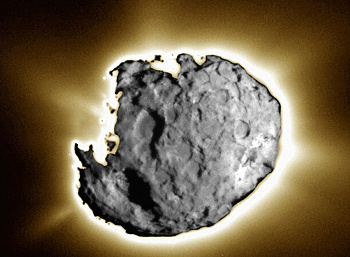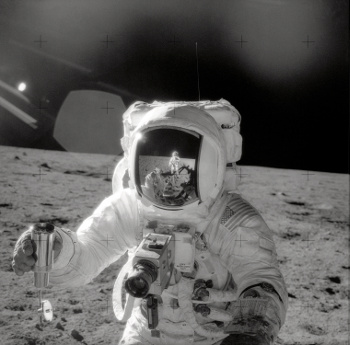Lunar Organics
December 21, 2015
While the
Earth is thought by most to be the only known reservoir of
organic chemicals, the
universe has been found to contain
many organics. In 1937,
Pol Swings and
Léon Rosenfeld used
spectroscopy to detect the
diatomic radical,
methylidyne (C-H), in
interstellar gas clouds.[1]
Eventually, more complex organic
molecules, including
polycyclic aromatic hydrocarbons, were detected in
nebulae, and polycyclic aromatic hydrocarbons have been detected also on
Saturn's moon,
Titan.[2]
Fullerene (C
60) was detected in a
planetary nebula by
NASA's Spitzer space telescope in 2010.[3] In just a few decades, we've gone from discovery of a few simple
cosmic organic molecules, like
methane, discovered in 1991, to compounds as complex as those found in
petroleum and
coal.

Cosmic cocktails, anyone?
Ethanol, also known as grain alcohol, is one of the organic molecules discovered in space.
(Via Wikimedia Commons.)
The abundance of organic compounds in space might have been seed material for the
genesis of life on Earth. Formation of the complex constituents of life would have been easier if such basic
ingredients were abundant. In fact, the
sugar molecule,
glycolaldehyde, was detected around the
protostellar binary IRAS 16293-2422, an object quite near the Earth, by
radio astronomers at the
Atacama Large Millimeter/submillimeter Array.[4-5] Glycolaldehyde is a
precursor to the formation of
ribonucleic acid, RNA, and its presence in an emergent star system indicates that such
chemicals would have
condensed onto
planets as they formed.
This
conjecture was buttressed by the detection of
glycine (NH
2CH
2COOH), one of the twenty
amino acid building blocks of life, in the
comet,
Wild 2. Glycine was found in a return sample from this comet by NASA's
Stardust spacecraft.[6-7] I wrote about the Stardust mission in a
previous article (Stardust, August 20, 2014).

The nucleus of comet, Wild 2, as seen by the Stardust spacecraft.
(NASA Image.)
On January 2, 2004, the Stardust spacecraft collected debris surrounding Wild 2 in a collection grid filled with
aerogel. The aerogel, which is 99% empty space, gently captured samples of the comet's dust trail, and the collection module was returned to Earth, where it landed by
parachute on January 15, 2006.
Jamie Elsila,
principal investigator of the glycine study and an
astrochemist at
NASA's Goddard Space Flight Center (Greenbelt, Maryland), remarked at the time of this discovery,
"Glycine is an amino acid used by living organisms to make proteins, and this is the first time an amino acid has been found in a comet... Our discovery supports the theory that some of life's ingredients formed in space and were delivered to Earth long ago by meteorite and comet impacts."[7]
Lunar regolith (soil) specimens collected during the
Apollo missions were found to contain up to 70 parts-per-billion (ppb) of amino acids, the most abundant being glycine.[8-9] A problem of interpretation arose because of several possible sources for these small
concentrations. These amino acids could have been
contamination from terrestrial sources through two routes; namely, material brought to the moon by the Apollo spacecraft, or contamination during handling on Earth.[9]
Another possibility was that the compounds were
synthesized from
precursors in
lunar module rocket exhaust.[9] Likewise, a similar thing might have happened with material transported from the
Sun to the Moon via the
solar wind.[9] Finally, the amino acids could have come from an infall of
asteroid and cometary material.[9] As
published in a recent paper in
Geochimica et Cosmochimica Acta, it appears that the lunar sample amino acids were from terrestrial contamination.

Apollo 12 astronaut, Alan L. Bean, collecting lunar regolith.
Bean was the pilot for the Lunar Module that landed in the Oceanus Procellarum (Ocean of Storms). Photographer Charles "Pete" Conrad, Jr., is mirrored in Bean's visor.
(NASA photo.)
As lead author of the
Geochimica et Cosmochimica Acta paper, Jamie Elsila, explains,
"People knew amino acids were in the lunar samples, but they didn't know where they came from... The scientists in the 1970s... were limited by the analytical capabilities of the time. We have the technology now, and we've determined that most of the amino acids came from terrestrial contamination, with perhaps a small contribution from meteorite impacts."[9]
The research team, composed of scientists from the Goddard Space Flight Center, the
Catholic University of America (Washington, DC), and the NASA
Johnson Space Center (Houston, Texas) analyzed return samples from the
Apollo 16 and
Apollo 17 missions using
time-of-flight mass spectrometry,
ultrahigh-performance liquid chromatography with
fluorescence detection, and compound-specific
carbon isotopic ratios.[8] All measurements were consistent with terrestrial sources, and it was concluded that terrestrial biological contamination was a primary source of the amino acids.[8]
They also looked for a
correlation between distance from the Apollo 17 lunar module rocket exhaust and amino acid concentration, and none was found.[8] As for a solar wind source, the
carbon-13 isotope concentration was higher than that of the solar wind. Furthermore, surface regolith that should have had more amino acids from solar wind exposure than deeper soil specimens were found to have less.[8-9]
The conclusion is that greater care should be taken in future sample return missions to prevent terrestrial contamination.[9] This research was supported by NASA's
Lunar Advanced Science and Exploration Research (LASER) Program, the
NASA Astrobiology Institute, and the
Goddard Center for Astrobiology.
References:
- Pol Swings and Léon Rosenfeld, "Considerations Regarding Interstellar Molecules," Astrophysical Journal, vol. 86 (November, 1937), p.483-486, DOI: 10.1086/143880.
- Manuel López-Puertas, "PAH's in Titan's Upper Atmosphere, Instituto de Astrofísica de Andalucía - CSIC, June 6, 2013.
- D. A. García-Hernández, A. Manchado, P. García-Lario, L. Stanghellini, E. Villaver, R. A. Shaw, R. Szczerba, and J. V. Perea-Calderón, "Formation Of Fullerenes In H-Containing Planetary Nebulae," The Astrophysical Journal Letters, vol. 724, no. 1 (October 28, 2010), pp. L39-L43. This paper is available as arXiv:1009.4357.
- Sweet Result from ALMA, ALMA Observatory Press Release, August 29, 2012.
- Jes K. Jørgensen, Cécile Favre, Suzanne E. Bisschop, Tyler L. Bourke, Ewine F. van Dishoeck, and Markus Schmalzl, "Detection of the simplest sugar, glycolaldehyde, in a solar-type protostar with ALMA," The Astrophysical Journal Letters, vol. 757, no. 1 (August 29, 2012), L4. This paper is available as arXiv:1208.5498.
- Jamie E. Elsila, Daniel P. Glavin and Jason P. Dworkin, "Cometary glycine detected in samples returned by Stardust," Meteoritics & Planetary Science, vol. 44, no. 9 (September, 2009), pp. 1323-1330. This is an open access publication with a PDF file available here.
- NASA Researchers Make First Discovery of Life's Building Block in Comet, NASA Press Release, August 17, 2009.
- Jamie E. Elsila, Michael P. Callahan, Jason P. Dworkin, Daniel P. Glavin, Hannah L. McLain, Sarah K. Noble, Everett K. Gibson Jr., "The origin of amino acids in lunar regolith samples," Geochimica et Cosmochimica Acta, vol. 172 (January 1, 2016), pp. 357-369, doi:10.1016/j.gca.2015.10.008. This is an open access article with a PDF file available at the same URL.
- Bill Steigerwald, "New NASA Study Reveals Origin of Organic Matter in Apollo Lunar Samples," NASA Goddard Space Flight Center Press Release, Oct. 28, 2015.
Permanent Link to this article
Linked Keywords: Earth; organic compound; organic chemical; universe; interstellar and circumstellar molecules; Pol Swings; Léon Rosenfeld; spectroscopy; diatomic molecule; radical; methylidyne; interstellar medium; interstellar gas cloud; molecule; >polycyclic aromatic hydrocarbon; nebula; Saturn; natural satellite; moon; Titan; fullerene; planetary nebula; NASA; Spitzer space telescope; cosmic; methane; petroleum; coal; cocktail; ethanol; Wikimedia Commons; abiogenesis; genesis of life on Earth; ingredient; monosaccharide; sugar; glycolaldehyde; protostar; protostellar; binary star; IRAS 16293-2422; radio astronomy; radio astronomer; Atacama Large Millimeter/submillimeter Array; precursor; RNA; ribonucleic acid; chemical compound; condensation; condense; plane; conjecture; glycine; amino acid; comet; Wild 2; Stardust spacecraft; comet nucleus; NASA; aerogel; parachute; Jamie Elsila; principal investigator; astrochemistry; astrochemist; Goddard Space Flight Center (Greenbelt, Maryland); living organism; protein; theory; meteorite; lunar soil; lunar regolith; Apollo missions; concentration; contamination; chemical synthesis; synthesize; precursor; lunar module; descent Propulsion System; rocket exhaust; Sun; solar wind; asteroid; scientific literature; publish; Geochimica et Cosmochimica Acta; Apollo 12; astronaut; Alan L. Bean; pilot; Oceanus Procellarum; photographer; Charles "Pete" Conrad, Jr.; visor; scientist; analytical chemistry; technology; Catholic University of America (Washington, DC); Johnson Space Center (Houston, Texas); Apollo 16; Apollo 17; time-of-flight mass spectrometry; ultrahigh-performance liquid chromatography; fluorescence detection; carbon isotopic ratios; correlation; carbon-13 isotope; Lunar Advanced Science and Exploration Research (LASER) Program; NASA Astrobiology Institute; Goddard Center for Astrobiology.